
The Blue Angels, formally named the U.S. Navy Flight Demonstration Squadron, are a flight demonstration squadron of the United States Navy. Formed in 1946, the unit is the second oldest formal aerobatic team in the world, after the French Patrouille de France formed in 1931. The team, composed of six Navy and one Marine Corps demonstration pilot, fly Boeing F/A-18 Super Hornets.

The Royal Flying Corps (RFC) was the air arm of the British Army before and during the First World War until it merged with the Royal Naval Air Service on 1 April 1918 to form the Royal Air Force. During the early part of the war, the RFC supported the British Army by artillery co-operation and photographic reconnaissance. This work gradually led RFC pilots into aerial battles with German pilots and later in the war included the strafing of enemy infantry and emplacements, the bombing of German military airfields and later the strategic bombing of German industrial and transport facilities.

Battle of Britain is a 1969 British war film directed by Guy Hamilton, and produced by Harry Saltzman and S. Benjamin Fisz. The film documents the events of the Battle of Britain. The film drew many respected British actors to accept roles as key figures of the battle, including Laurence Olivier as Air Chief Marshal Sir Hugh Dowding, Trevor Howard as Air Vice-Marshal Keith Park, and Patrick Wymark as Air Vice-Marshal Trafford Leigh-Mallory. It also starred Michael Caine, Christopher Plummer, and Robert Shaw as Squadron Leaders. The script by James Kennaway and Wilfred Greatorex was based on the book The Narrow Margin by Derek Wood and Derek Dempster.
Squadron Commander Christopher Draper, was an English flying ace of World War I. His penchant for flying under bridges earned him the nickname "the Mad Major". After the war he became a film star through his work both as a stunt pilot and as an actor. During the 1930s he worked for a time as a British secret agent, serving as a double agent to Nazi Germany. He returned to the Navy in World War II. During his flying career he logged over 17,000 flying hours on 73 types of aircraft.
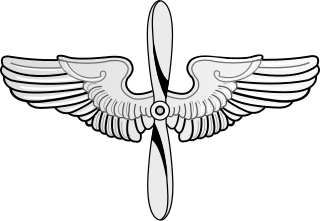
The United States Army Air Service (USAAS) was the aerial warfare service component of the United States Army between 1918 and 1926 and a forerunner of the United States Air Force. It was established as an independent but temporary branch of the U.S. War Department during World War I by two executive orders of President Woodrow Wilson: on May 24, 1918, replacing the Aviation Section, Signal Corps as the nation's air force; and March 19, 1919, establishing a military Director of Air Service to control all aviation activities. Its life was extended for another year in July 1919, during which time Congress passed the legislation necessary to make it a permanent establishment. The National Defense Act of 1920 assigned the Air Service the status of "combatant arm of the line" of the United States Army with a major general in command.
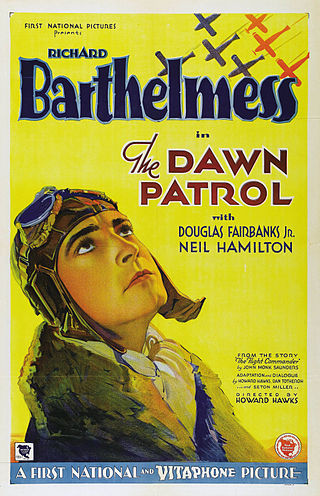
The Dawn Patrol is a 1930 American pre-Code World War I film starring Richard Barthelmess and Douglas Fairbanks Jr. It was directed by Howard Hawks, a former World War I flight instructor, who even flew in the film as a German pilot in an uncredited role. The Dawn Patrol won the Academy Award for Best Story for John Monk Saunders, an American writer said to have been haunted by his inability to get into combat as a flyer with the U.S. Air Service. It was subsequently remade in 1938 with the same title, and the original was then renamed Flight Commander and released later as part of the Warner Bros. film catalog.
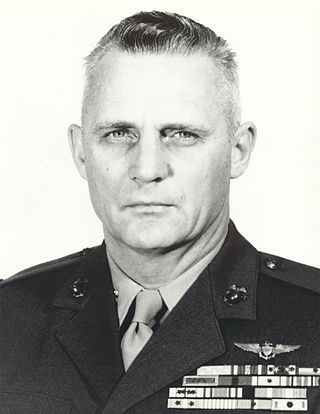
Kenneth Ambrose Walsh was a United States Marine Corps lieutenant colonel and a Medal of Honor recipient who was the fourth ranking USMC fighter ace in World War II with a record of 21 enemy planes destroyed. He also served in Korea during the first year of the Korean War and retired from the Marine Corps in February 1962.

Fighter Squadron is a 1948 American World War II aviation war film in Technicolor from Warner Bros., produced by Seton I. Miller, directed by Raoul Walsh, that stars Edmond O'Brien, Robert Stack, and John Rodney.

Cedric Ernest "Spike" Howell, was an Australian fighter pilot and flying ace of the First World War. Born in Adelaide, South Australia, he enlisted in the Australian Imperial Force in 1916 for service in the First World War and was posted to the 46th Battalion on the Western Front. In November 1916, he was accepted for a transfer to the Royal Flying Corps and was shipped to the United Kingdom for flight training. Graduating as a pilot, he was commissioned as a second lieutenant and posted to No. 45 Squadron RFC in France during October 1917; two months later the unit sailed to the Italian theatre.

Death in the Air is a 1937 American film directed by Elmer Clifton and starring Lona Andre, John Carroll, Leon Ames and Henry Hall. The film is also known as Murder in the Air in the United Kingdom and as The Mysterious Bombardier. The film was Fanchon Royer's first production for her new company, Fanchon Royer Features, Inc. Film Daily reported that former FBI agent Melvin Purvis was offered a role in the film but declined.

Captain Henry Robinson Clay, Jr. was a World War I flying ace credited with eight confirmed aerial victories.
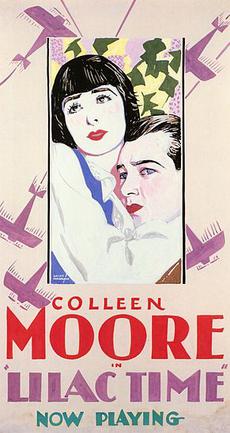
Lilac Time is a 1928 American synchronized sound romantic war film directed by George Fitzmaurice and starring Colleen Moore and Gary Cooper. While the film has no audible dialog, it was released with a synchronized musical score with sound effects using the sound-on-disc Vitaphone process. The film is about young American aviators fighting for Britain during World War I who are billeted in a field next to a farmhouse in France. The daughter who lives on the farm meets one of the new aviators who is attracted to her. As the flyers head off on a mission, the young aviator promises to return to her.

Wing Commander Mark Henry Brown, was a Canadian-born flying ace who served with the Royal Air Force (RAF) during the Second World War. Credited with having shot down at least fifteen German aircraft, he was the first Canadian pilot to become a flying ace during the war. He was killed in action in November 1941 over Sicily.

Flight Lieutenant Nicholas Gresham Cooke, DFC, nicknamed "Lanky", was a Royal Air Force pilot and Second World War flying ace most notable as an ace in a day. He was killed in action over the Dunkirk evacuation beaches.

Gerald Richard Johnson was a World War II flying ace who flew for the United States Army Air Forces. Johnson commanded the 9th Fighter Squadron and 49th Fighter Group, and became the fourth ranking fighter ace in the Pacific during World War II. He ended his war career with 22 kills.
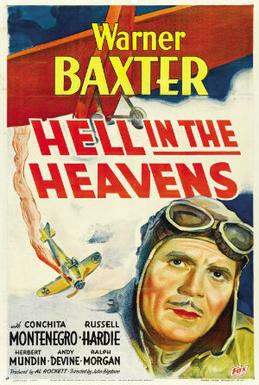
Hell in the Heavens is a 1934 American aviation drama film directed by John G. Blystone and written by Byron Morgan, Ted Parsons and Jack Yellen based on the stage play Der Flieger by Hermann Roßmann. The film stars Warner Baxter, Conchita Montenegro, Russell Hardie, Herbert Mundin, Andy Devine and William Stelling. It was released on November 9, 1934 by Fox Film Corporation.
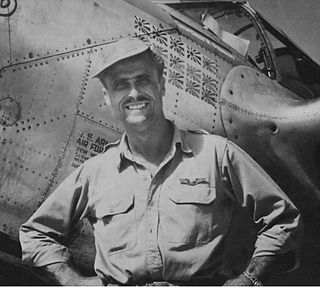
Robert Burdette Westbrook was a United States Army Air Forces lieutenant colonel and a World War II flying ace. Westbrook commanded the 44th Fighter Squadron, and became the leading fighter ace of the Thirteenth Air Force. He is also the ninth ranking fighter ace in the Pacific during World War II and also one of ten United States Army Air Forces pilots who became an ace in two different types of fighter aircraft.

Frank Clarke was a Hollywood stunt pilot, actor, and military officer. His most prominent role was as Leutnant von Bruen in the 1930 production Hell's Angels, but he flew for the camera and performed stunts in more than a dozen films in the 1930s and 1940s. Clarke was killed in an aircraft crash near Isabella, California, in 1948.
Gilbert O. Wymond Jr. (1919–1949) was a United States Army Air Forces fighter pilot during World War II with service overseas in Africa and Italy campaigns. He was noted for his feature role in the filming of the documentary Thunderbolt (1947).
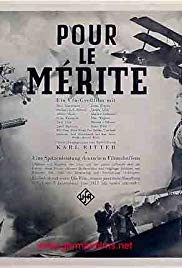
Pour le Mérite is a 1938 propaganda film produced and directed by Karl Ritter for Nazi Germany. The film follows the story of officers of the Luftstreitkräfte in the First World War who were later involved in the formation of the Luftwaffe. Pour le Mérite propagates the "stab legend", which consigns the German military defeat in World War I to an alleged treason in the homeland. At the same time, Ritter also glorifies the former fighter pilots as heroes of National Socialism.


















